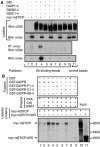Sonic hedgehog signaling regulates Gli2 transcriptional activity by suppressing its processing and degradation
- PMID: 16611981
- PMCID: PMC1447407
- DOI: 10.1128/MCB.26.9.3365-3377.2006
Sonic hedgehog signaling regulates Gli2 transcriptional activity by suppressing its processing and degradation
Abstract
Gli2 and Gli3 are the primary transcription factors that mediate Sonic hedgehog (Shh) signals in the mouse. Gli3 mainly acts as a transcriptional repressor, because the majority of full-length Gli3 protein is proteolytically processed. Gli2 is mostly regarded as a transcriptional activator, even though it is also suggested to have a weak repressing activity. What the molecular basis for its possible dual function is and how its activity is regulated by Shh signaling are largely unknown. Here we demonstrate that unlike the results seen with Gli3 and Cubitus Interruptus, the fly homolog of Gli, only a minor fraction of Gli2 is proteolytically processed to form a transcriptional repressor in vivo and that in addition to being processed, Gli2 full-length protein is readily degraded. The degradation of Gli2 requires the phosphorylation of a cluster of numerous serine residues in its carboxyl terminus by protein kinase A and subsequently by casein kinase 1 and glycogen synthase kinase 3. The phosphorylated Gli2 interacts directly with betaTrCP in the SCF ubiquitin-ligase complex through two binding sites, which results in Gli2 ubiquitination and subsequent degradation by the proteasome. Both processing and degradation of Gli2 are suppressed by Shh signaling in vivo. Our findings provide the first demonstration of a molecular mechanism by which the Gli2 transcriptional activity is regulated by Shh signaling.
Figures







References
-
- Aoto, K., T. Nishimura, K. Eto, and J. Motoyama. 2002. Mouse GLI3 regulates Fgf8 expression and apoptosis in the developing neural tube, face, and limb bud. Dev. Biol. 251:320-332. - PubMed
-
- Ausubel, Frederick M., R. Brent, Robert E. Kingston, David D. Moore, J. G. Seidman, and Kevin Struhl (ed.). 1988. Current protocols in molecular Biology. John Wiley & Sons, Inc., Hoboken, N.J.
-
- Aza-Blanc, P., H. Y. Lin, A. Ruiz i Altaba, and T. B. Kornberg. 2000. Expression of the vertebrate Gli proteins in Drosophila reveals a distribution of activator and repressor activities. Development 127:4293-4301. - PubMed
-
- Aza-Blanc, P., F. A. Ramirez-Weber, M. P. Laget, C. Schwartz, and T. B. Kornberg. 1997. Proteolysis that is inhibited by hedgehog targets Cubitus interruptus protein to the nucleus and converts it to a repressor. Cell 89:1043-1053. - PubMed
-
- Bai, C. B., W. Auerbach, J. S. Lee, D. Stephen, and A. L. Joyner. 2002. Gli2, but not Gli1, is required for initial Shh signaling and ectopic activation of the Shh pathway. Development 129:4753-4761. - PubMed
Publication types
MeSH terms
Substances
Grants and funding
LinkOut - more resources
Full Text Sources
Other Literature Sources
Molecular Biology Databases
